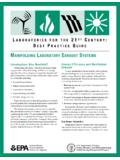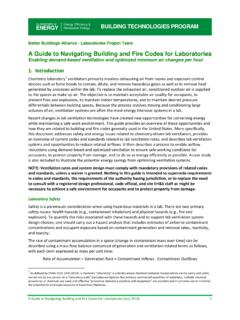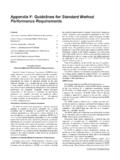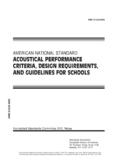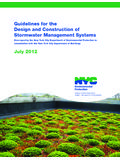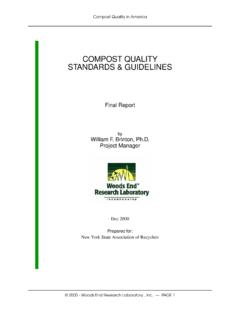Transcription of Labs21 Environmental Performance Criteria 3 - I2SL
1 Labs21 Environmental Performance Criteria 7 November 2010. EPC Version 3 Developers Dan Amon Environmental Protection Agency Karl Aveard erlab Inc. Jeff Beeden Becht Engineering Geoffrey Bell Lawrence Berkeley National Laboratory John Breshears ZGF Architects Michael Briselden Whiting-Turner Nancy Carlisle National Renewable Energy Laboratory Wade Conlan X-nth William Cowdell University of California, Irvine Paul Erickson Affiliated Engineers, Inc. Peter Gardner Torcon Lou Hartman Harley Ellis Devereaux Punit Jain Cannon Design Richard Johnson Thermo Fisher William Lintner Department of Energy Paul Mathew Lawrence Berkeley National Laboratory John Mlade Perkins & Will Gerry Palau Oak Ridge National Laboratory Joe Phillips Phillips Collaborative George Sestak Astra Zeneca William Starr University of California, Davis Mike Walters Affiliated Engineers, Inc.
2 John Weale Rumsey Engineers, Inc. Kath Williams Kath Williams Associates Phil Wirdzek I2SL. Please direct questions and comments to: Paul Mathew, Lawrence Berkeley National Laboratory email: voice: 510-486-5116. Table of Contents Sustainable Sites .. 3. SS EPC Credit 1 Safety and Risk Management for Air Effluents ..3. Water 4. WE EPC Prerequisite 1 Laboratory Equipment Water Use ..4. WE EPC Credit 1 Process Water Efficiency ..5. Energy & Atmosphere .. 6. EA EPC Prerequisite 1 Assess Minimum Ventilation Requirements ..6. EA EPC Credit 1 Improve Laboratory Equipment EA EPC Credit 2 Right-size Laboratory Equipment Load ..8. Materials & Resources .. 10. MR EPC Prerequisite 1 Hazardous Material MR EPC Credit 1 Chemical Resource Management ..11. Indoor Environmental Quality .. 12. EQ EPC Prerequisite 1 Laboratory Ventilation ..12. EQ EPC Prerequisite 2 Protection and Notification Systems.
3 13. EQ EPC Credit 1 Laboratory Air Flow Analysis ..14. EQ EPC Credit 2 Containment Device Commissioning ..15. Labs21 Environmental Performance Criteria Version 1. Overview Laboratory facilities present a unique challenge for energy efficient and sustainable design, with their inherent complexity of systems, health and safety requirements, long-term flexibility and adaptability needs, energy use intensity, and Environmental impacts. The Labs21 Environmental Performance Criteria (EPC) complements the Green Building Council's widely used Leadership in Energy and Environmental Design for New Construction (LEED-NC) rating system, extending it to set appropriate and specific requirements for laboratories. The EPC is a public domain document that is available for anyone to use in their laboratory projects. The EPC was developed by the Laboratories for the 21st Century ( Labs21 ) Program ( ).
4 Labs21 is aimed at improving Environmental Performance of laboratory buildings. The lead sponsors of the Labs21 Program are the Department of Energy's Federal Energy Management Program (FEMP) and the Environmental Protection Agency (EPA). Using the EPC. The EPC should be used in conjunction with LEED-NC 2009. The EPC only addresses Environmental Performance factors that are not addressed by LEED-NC 2009. The EPC credits include EPC in the credit label prefix to distinguish them from LEED credits. Projects that are pursuing LEED certification may consider submitting the EPC credits as innovation points. Labs21 does not provide a certification process for the EPC. Changes in Version Version is a substantial revision of the earlier version of the EPC to better align with LEED. 2009 and developments in industry practice over the last few years.
5 Some of the key changes include the following: Deleted the sustainable sites credit for liquid effluents as this is covered in the EPC. prerequisite for hazardous material handling. Added a credit for process water metering. Changed the approach for the laboratory equipment efficiency credit to make it more usable and specified a list of qualifying equipment. Added a requirement in the laboratory right sizing credit to develop a plan to meter laboratory equipment energy use and add these data to the Labs21 database. Changed the EPC credit for protection and notification systems to a prerequisite. EPC version has a total of 7 credits and 5 prerequisites. Labs21 Environmental Performance Criteria Version 2. Sustainable Sites SS EPC Credit 1 Safety and Risk Management for Air Effluents Intent Minimize Environmental , safety and health impacts of laboratory exhausts on site and neighbors.
6 Requirement Meet all standards and generally accepted guidelines for outdoor protection of workers and general public from airborne chemical, radioactive and biological hazards. Use mathematical modeling, physical modeling and/or post-construction testing and certification to prove compliance. Use effluent controls that minimize generation of waste subject to special regulations. Strategies To protect workers: Meet or exceed all exposure limits established by American Conference of Industrial Hygienists (ACGIH), Occupational Safety and Health Administration (OSHA), Nuclear Regulatory Commission (NRC), American National Standards Institute (ANSI), local standards or generally accepted best practice, whichever are most stringent. The requirement applies on rooftops, catwalks and all other areas which workers may reasonably occupy with systems in operation.
7 To protect visitors and the public: Meet or exceed all exposure limits established by EPA, other organizations, local standards or generally accepted best practice, whichever are most stringent. In the absence of guidance or defensible rationale, use 10 percent of the applicable workplace limit as a standard for visitor and public exposure. If the occupant's radiation safety staff requires air effluent precautions, verify that methods used to limit chemical exposures are adequate to protect against radioactive material releases or include additional precautions. Meet or exceed National Institutes of Health Centers for Disease Control (NIH-CDC). guidelines for airborne effluent from laboratories that handle biohazards (CDC-NIH. Biosafety in Microbiological and Biomedical Laboratories, latest edition). Develop credible worst-case assumptions of airborne releases.
8 Then use mathematical ( Computational Fluid Dynamics (CFD)) and/or physical ( wind tunnel) modeling to show that any target location (rooftop worker, operable window, air intake, pedestrian walk, etc.) will not be exposed to levels exceeding one-tenth of the appropriate standard with a probability greater than in any 7 day period one minute per week and/or verify safe building Performance by post-construction tracer gas studies under a variety of weather conditions and correct design problems immediately. Use filters only where justified. Avoid fiberglass or other duct liner exposed to exhaust stream. Select air cleaning systems for low waste generation as well as effectiveness. Test and certify all filters as installed prior to occupancy and placard them for at least annual re-certification. Labs21 Environmental Performance Criteria Version 3.
9 Water Efficiency WE EPC Prerequisite 1 Laboratory Equipment Water Use Intent Reduce water use for laboratory equipment. Requirements No potable water shall be used once-through for any laboratory equipment, unless it is required as direct contact process water. Definitions Direct contact process water is defined as any water that, during use, comes into direct contact with any raw material, product, or waste. Strategies Use closed-loop cooling water for equipment cooling. Use non-potable water sources. Use vacuum pumps instead of aspirator fittings at cold-water faucets. One way to encourage this is to specify the use of non-threaded faucets, unless threaded faucets are required for other laboratory functions Labs21 Environmental Performance Criteria Version 4. WE EPC Credit 1 Process Water Efficiency Intent Reduce process water use and process wastewater generation.
10 Requirements Calculate and document baseline of annual process water use and process wastewater discharge. The baseline for the proposed facility must be completed before any of the credits may be earned. Methods used to establish a baseline may include: measurement and comparisons of process water use at similar laboratories, and evaluation of the typical water use for laboratory equipment and processes. The method used to develop the baseline must be included with documentation of this credit. Credit (1 point): Install meter to measure total laboratory process water use. Any individual use that is estimated at more than 30% of total process water use should be sub-metered. Credit (1 point): Adopt technologies and strategies to reduce process water use and process wastewater generation by 20%. Document the reductions from baseline. Credit (1 point): Adopt technologies and strategies to reduce process water use and process wastewater generation by 30%.
